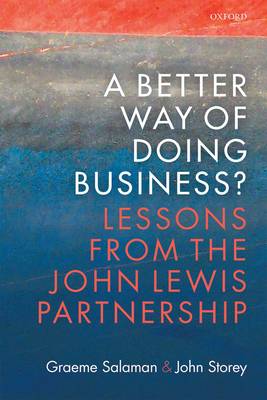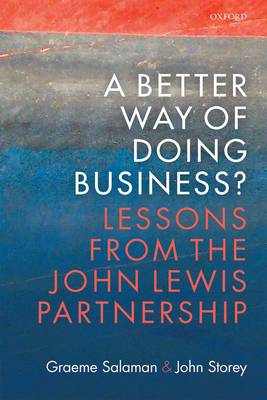
- Retrait gratuit dans votre magasin Club
- 7.000.000 titres dans notre catalogue
- Payer en toute sécurité
- Toujours un magasin près de chez vous
- Retrait gratuit dans votre magasin Club
- 7.000.0000 titres dans notre catalogue
- Payer en toute sécurité
- Toujours un magasin près de chez vous
A Better Way of Doing Business?
Lessons from The John Lewis Partnership
Graeme Salaman
Livre relié | Anglais
52,45 €
+ 104 points
Description
This book offers a thoroughly researched and accessibly written account of the John Lewis Partnership. It describes what the JLP is, how it works, and what other businesses can learn from it. The US/UK model of the firm, with its emphasis on shareholder value and its openness to the market in the buying and selling of businesses, is prone to a number of problematic consequences for employees, suppliers, and sometimes share-holders. The JLP represents a contrast to this model - one that has implications beyond the small niche of mutually-owned firms. The JLP has lessons for organizations that are unlikely to move towards the Partnership's distinctive shared ownership. This book identifies these lessons. The key questions addressed include: how does the JLP work in practice? What is the link between co-ownership, the JLP employment model, and the performance of the businesses? What is the role of management in the success of John Lewis and Waitrose? Are mutuality, co-ownership and business performance at odds? What is the significance of democracy within the JLP? And probably most significantly: what are the implications, for policy-makers and for economic agents of the JLP? This book is based on detailed knowledge of the JLP and its constituent business gathered by the authors over a fifteen year period. Their conclusion: that the JLP is more complex, even more impressive, and more interesting than its admirers realise.
Spécifications
Parties prenantes
- Auteur(s) :
- Editeur:
Contenu
- Nombre de pages :
- 250
- Langue:
- Anglais
Caractéristiques
- EAN:
- 9780198782827
- Date de parution :
- 05-10-16
- Format:
- Livre relié
- Format numérique:
- Genaaid
- Dimensions :
- 152 mm x 231 mm
- Poids :
- 430 g

Les avis
Nous publions uniquement les avis qui respectent les conditions requises. Consultez nos conditions pour les avis.






